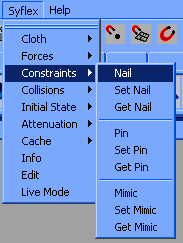|
|

-
Nails
Pins
Mimics
|
Nails

|
|
A nail fixes a set of vertices from the cloth.
The nail can be animated (as any transform).
To create nails: select vertices from the cloth, and chose in the menu:
Constraints > Nail
To edit the set of vertices in a nail: use:
Constraints > Get Nail
This selects all the vertices from the nail. The selection can be edited, by removing
or adding vertices. Call Constraints > Set Nail in the menu to validate the
new selection.
The vertices of the cloth can be completely constrained to follow the nails, or loosely constrained.
In this case the vertices are connected at some distance of the nail by a spring:

- Active
The constraint is applied only when this attribute is set to 'on'.
- Distance
Distance from the nail.
Distance=0 is a special case: the vertices of the cloth are constrained to fully follow the nails:
there is no spring in this case. This is faster to compute.
When Distance<0 the springs have no compression force.
- Stiff
Stiffness of the spring. Increase to have the vertex stay at the same distance from the nail
(in this case also increase the damping).
- Damp
Damping of the spring. Increase to remove vibrations.
|
Pins

|
|
A pin attaches vertices of a cloth to another polygonal object. When the object is
animated (using any transformation or deformation) the vertices of the cloth attached
to it will follow.
To create pins: select vertices from the cloth, shift-select an object, then choose Constraints > Pin
from the menu.
To edit the set of vertices in a pin: select in the menu Constraints > Get Pin.
This selects all the vertices from the pin. The selection can be edited, by removing
or adding vertices. Then call Constraints > Set Pin in the menu to validate the
new selection.
The vertices of the cloth can be completely constrained to follow the pins, or loosely constrained.
In this case the vertices are connected at some distance of the pins by a spring:

The pin has similar attributes to the nail. It has the following attributes:
- Active
The constraint is applied only when this attribute is set to 'on'.
- Distance
Distance from the pin.
Distance=0 is a special case: the vertices of the cloth are constrained to fully follow the pins:
there is no spring in this case. This is faster to compute.
When Distance<0 the springs have no compression force.
- Stiff
Stiffness of the spring. Increase to have the vertex stay at the same distance from the pin
(in this case also increase the damping).
- Damp
Damping of the spring. Increase to remove vibrations.
- Wrap
By default (wrap=0) the pinned points on the cloth stay at the same distance of the shape.
When wrap=1 the points are moved closer to the shape. Wrap can take values between 0 and 1.
|
Mimics

|
|
The Mimic constraint link the selected points of the cloth to the selected shape.
It is used to make the cloth mimic the deformations of another shape. For instance you can model
the cloth as you want it to look at the end of the animation, and have a syMimic to force the cloth
to resemble this shape.
The shape should have the same topology as the cloth.: the Ith vertex of the
cloth is constrained to the Ith vertex of the shape.
When the shape is animated (using any transformation or deformation) the vertices of the cloth
follow.
To create mimics: select vertices from the cloth, shift select a shape, then choose Constraints > Mimic
from the menu.
To edit the set of vertices in a mimic: select in the menu Constraints > Get Mimic.
This selects all the vertices from the syMimic. The selection can be edited, by removing
or adding vertices. Then call Constraints > Set Mimic in the menu to validate the
new selection.
The vertices of the cloth can be completely constrained to follow the shape, or loosely constrained.
In this case the vertices are connected at some distance of the shape by a spring:

The mimic has similar attributes to the pin. It has the following attributes:
- Active
The constraint is applied only when this attribute is set to 'on'.
- Distance
Distance from the shape.
Distance=0 is a special case: the vertices of the cloth are constrained to fully follow the shape:
there is no spring in this case. This is faster to compute.
When Distance<0 the springs have no compression force.
- Stiff
Stiffness of the springs. Increase to have the verticxes of the cloth stay at the same distance from the shape
(in this case also increase the damping).
- Damp
Damping of the spring. Increase to remove vibrations.
|

